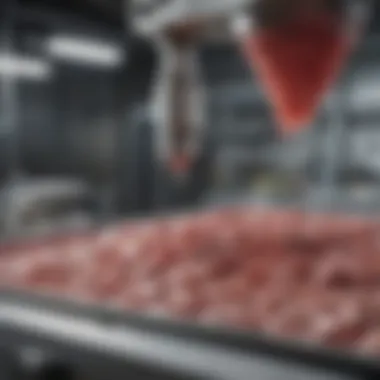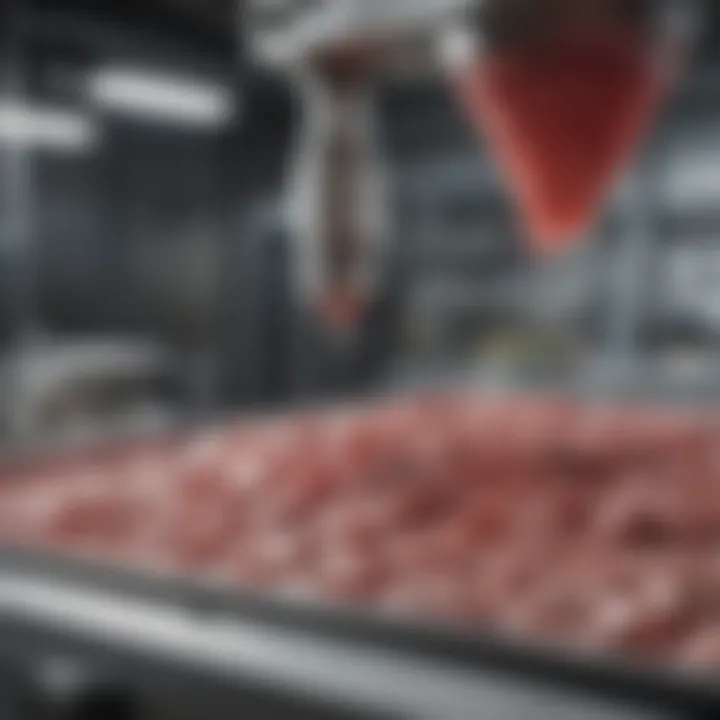Innovations in Meat Production Technology Today


Intro
The world of meat production is undergoing a transformation, driven by advances in technology that not only aim to bolster efficiency but also address pressing concerns related to sustainability and animal welfare. As we embark on this exploration of current advancements, it is essential to understand that the meat industry is at a crossroads. Traditional practices face challenges from both consumers and regulators, with rising awareness about environmental impacts and ethical considerations.
In recent years, the integration of cutting-edge techniques such as cellular agriculture and precision fermentation continues to reshape the landscape of meat production. These innovations could lead to significant improvements in the resource efficiency of meat manufacturing processes. Notably, as these technologies develop, the implications stretch far beyond production methods; they echo through societal and ecological spheres, influencing food security and environmental sustainability on a global scale.
This article serves as a comprehensive guide, diving deep into the methodologies that underpin recent advancements while examining their significance for students, researchers, educators, and professionals in the field. By outlining both historical and future perspectives, we aim to equip our audience with a nuanced understanding of how meat production technology is evolving and what this means for the future.
"Enhancements in meat production technology are not just innovations for efficiency; they are steps towards a more sustainable future for our planet."
From analyzing traditional methods to uncovering the potential of state-of-the-art practices, we will gather insights that help paint a clearer picture of an industry that is adapting to meet the demands of today’s society. Prepare for a detailed examination of methodologies, prominent technologies, and the future pathways that lie ahead.
Preamble to Meat Production Technology
Meat production technology serves as a crucial backbone for not just the food industry but also for economic stability and public health around the globe. With rising populations and shifts in dietary patterns, the need for innovative and efficient meat production techniques has never been more pressing. This article delves into the intricate details surrounding advancements in this field, highlighting methods and technologies that promise to improve sustainability, quality, and efficiency in meat manufacturing.
The significance of understanding meat production technology stems mainly from the growing awareness of its impacts on environmental sustainability, animal welfare, and food security. As more consumers become conscious of where their food comes from, practices that prioritize ethical considerations will begin to trend. Technologies such as cellular agriculture and precision fermentation showcase the kind of innovative thinking needed to address these concerns effectively.
Exploring this technology isn’t just about meat; it's about the collective future of our food systems and the balance between advancing culinary delights and ensuring environmental responsibility. Thus, individuals involved in policy-making, agribusiness, and education should take note. It’s essential to underscore how these advancements can help satisfy the difficult balancing act of addressing the rising meat demands of consumers while promoting ethical production and sustainable practices.
The Evolution of Meat Production
Over centuries, the methods of meat production have transformed dramatically from simple hunting and agrarian practices to highly complex industrial systems. Initially, meat procurement was a matter of survival; communities relied on hunting and local husbandry practices. However, as populations grew, these early forms could not sustain the increasing demand.
By the early 20th century, mechanization started revolutionizing meat production. The advent of assembly line methods, pioneered by industries like Ford's automobile factory, brought about unprecedented efficiency. While this allowed for large-scale production, it also introduced significant challenges. Questions regarding animal welfare, environmental impacts, and the quality of the meat began to surface as the techiue became more industrialized.
Fast forward to today, we see a new wave of evolution focused on addressing these very concerns. From vertical farms that allow for sustainable livestock rearing to biotechnological advancements that enable lab-grown meats, the modernization of meat production continues to redefine what we can expect for our plates in the coming years.
Current Global Trends in Meat Consumption
Meat consumption patterns reflect deeper societal changes, guided by culture, economy, and increasingly, environmental conscience. Today, the world has entered an era where flexitarianism—a diet primarily based on plants, with occasional meat consumption—gains traction, particularly among younger demographics. This shift is paired with a notable demand for transparency about how meat is produced. The public is keen on understanding "What’s really in my meat?" Conscious consumerism is the name of the game.
Here's how current trends break down:
- Increased Demand for Quality: Consumers are shifting from quantity to quality, showing preference for sustainably produced meats, which usually come at a premium.
- Growth of Alternative Protein Sources: Plant-based diets are promoted as more sustainable, leading labels like Impossible Foods and Beyond Meat to rise in popularity.
- Technological Integration in Supply Chains: Blockchain and data analytics tools are becoming essential for tracking meat from farm to table, enhancing oversight and ensuring accountability.
Traditional Meat Production Methods
To grasp the current advancements in meat production technology, it's essential to first appreciate the foundation laid by traditional methods. These techniques have been honed over centuries, deeply woven into different cultures and economies. Understanding these methods illuminates the significance of innovations that have emerged recently, presenting a comprehensive perspective on how technology is reshaping this vital industry.
Conventional Livestock Farming Techniques
Conventional livestock farming is the backbone of traditional meat production. This method typically involves raising animals like cattle, pigs, and chickens in expansive facilities, known as feedlots or barns. Farmers focus on breeding and raising livestock for meat to meet consumer demands. The entire process, from breeding to slaughter, has typically relied on time-tested practices and the natural instincts of animals.
However, this methodology is not without its challenges. Land use, water consumption, and the environmental footprint of large-scale operations have consistently come under scrutiny. Moreover, ethical considerations regarding the treatment of animals have pushed some consumers to rethink their meat choices. The balance between efficiency and sustainability becomes a tightrope walk, making it crucial for farmers to adopt more conscious practices while maximizing output.
"With traditional methods, we see a blend of art and science, carefully crafted over generations, forming the basis of modern practices."


Processing Practices in Traditional Meat Production
Once livestock is raised, the next vital facet is processing. Traditional processing practices play a pivotal role in determining meat quality and food safety. After slaughter, meat requires careful handling. Basic practices include skinning, gutting, and cooling. Each of these steps is crucial in preventing spoilage and ensuring freshness.
Historically, local butchers performed the processing. This hands-on approach allowed for immediate quality control, where the butcher knew their products inside and out. As consumer preferences shifted and urbanization took hold, larger meatpacking plants emerged, leading to mass production techniques that changed the landscape of meat processing.
Some key elements of traditional processing include:
- Artisanal Techniques: Small-scale producers often employ unique curing, smoking, or aging processes, resulting in distinct flavors that larger operations may lack.
- Regulatory Compliance: Traditional methods must still align with health regulations, ensuring that safety standards are upheld throughout the production chain.
That said, as the meat industry evolves, some of these traditional practices are being reassessed against emerging technologies designed to optimize and enhance processing efficiency. Understanding these conventional techniques anchors our comprehension of current advancements, ultimately helping both consumers and producers navigate the changing landscape of meat production.
Innovations in Meat Production Technology
The realm of meat production is undergoing a transformation, driven by the pressing need for sustainability, efficiency, and quality. Innovations in this field are not merely technological improvements but are pivotal to reshaping how meat is produced and consumed. Recent advancements tackle multifaceted issues, such as environmental impact and the ethical treatment of animals, while responding to a global increase in demand for protein sources. These innovations promise a future where meat production aligns more closely with societal values and ecological constraints.
Cellular Agriculture Explained
Cellular agriculture is rapidly gaining traction within the food production sector. This concept revolves around the cultivation of agricultural products from cell cultures, rather than traditional farming methods. The core principle here is to create meat in a laboratory setting, which might sound futuristic, but it’s already being applied in practice.
Definition and Principles
The definition of cellular agriculture hinges on the idea of producing animal products without requiring the entire animal. This goes against the grain of conventional meat production, where livestock is bred, raised, and harvested. The key characteristic of this method is its focus on cell culture techniques, which utilize stem cells from live animals and grow them in a nutrient-rich environment.
This method is gaining favor because it promises to tool the meat production landscape with several benefits. First and foremost, it has the potential to slash greenhouse gas emissions significantly. By reducing the need for extensive land and water use, this process also holds significant weight in discussions surrounding environmental sustainability.
One unique feature of cellular agriculture is its ability to provide consistent quality and safety in meat products. Since these cells are cultivated in controlled environments, the chances of contamination diminish markedly compared to traditional farming. Nevertheless, it’s crucial to address some disadvantages, such as high initial costs and regulatory hurdles that accompany novel food technologies.
Applications in Meat Production
The application of cellular agriculture spans various facets of meat production, paving the way for cultivated meat products that mimic traditional cuts, like beef, chicken, or pork. This approach is more than a niche; it has the potential to redefine how meat is perceived and produced.
One of the standout characteristics of this application is its flexibility—scientists can modify the cell cultures to produce tailored flavor profiles, textures, and even nutritional content. This customization is advantageous as it caters directly to consumer preferences that continually evolve in today’s market.
However, the unique feature of this application raises questions about consumer acceptance. While many individuals may be intrigued by lab-grown meat, there still remains a segment of the population hesitant about its safety and taste. Consequently, despite various advantages, including the reduction of animal suffering and a decreased environmental footprint, overcoming consumer skepticism is a hurdle that needs addressing for cultivated meat to gain widespread traction.
Precision Fermentation Technologies
In the arena of meat production technology, precision fermentation is capturing attention as a viable alternative to conventional practices. This technique enables the production of specific ingredients through microbial systems, often resulting in enhancements to existing meat substitutes or even the creation of new products altogether. By harnessing the power of fermentation, producers can create proteins, fats, and other components that deliver flavor and texture similar to that of meat, without relying heavily on animal agriculture.
In essence, precision fermentation leverages the skills of microorganisms to create what might otherwise take large quantities of livestock to produce. This innovative method offers a promising pathway toward creating a wide variety of meat products that cater to diverse tastes while maintaining an environmentally sustainable footprint. As such, it could serve as a game-changer in how both meat producers and consumers approach the concept of meat.
Environmental Impact of Meat Production
The meat production industry has a profound effect on the environment, making it a critical topic in today’s discourse on sustainability. As societies gear up to meet the ever-growing demand for meat, the ramifications of traditional methods are becoming evident. The relevance of discussing environmental impacts cannot be overstated; it sheds light on the intricate balance between food production and ecological integrity. Understanding these effects helps us determine ways to mitigate them, allowing for a more sustainable approach toward farming and consumption.
Meat Production and Climate Change
The correlation between meat production and climate change is as clear as day. Livestock farming is one of the primary contributors to greenhouse gas emissions, with studies suggesting that it accounts for nearly 14.5% of all human-induced emissions. These emissions stem from several sources, including methane released during digestion, nitrous oxide from manures, and carbon dioxide from agricultural practices. When you consider the scale, it's startling how much impact the meat industry has on our planet’s changing climate.


For instance, the Amazon rainforest, often referred to as the lungs of the Earth, is being relentlessly cleared for cattle ranching. Every acre lost contributes not only to lost biodiversity but also to increased carbon dioxide levels in the atmosphere. Furthermore, the water footprint of meat production is alarmingly high; it requires approximately 1,800 gallons of water just to produce a single pound of beef. In a world where freshwater scarcity is becoming an alarming issue, this is not a number to shrug off.
"We cannot afford to overlook the dire connections between our eating habits and the planet’s health. It’s high time we rethink our consumption patterns."
Sustainable Practices in Modern Meat Production
In light of these environmental challenges, sustainable practices have emerged as vital innovations within the meat industry. Transitioning towards more ecologically sound methods can greatly alleviate some of the negative impacts. Here are a few sustainable approaches being adopted:
- Regenerative Agriculture: This method focuses on improving soil health and sequestering carbon. Farmers employ rotational grazing, cover cropping, and permaculture principles, aiming to create a resilient ecosystem that enhances both food production and biodiversity.
- Alternative Proteins: Thinking outside the box, products derived from plants and lab-grown meat offer promising alternatives to traditional livestock. These methods utilize significantly less land and water, minimizing the carbon emissions associated with conventional meat production.
- Waste Minimization: Integrating a closed-loop system can help reduce waste in meat processing. By utilizing by-products for other purposes, such as animal feed or biofuel, farms enhance sustainability without compromising operational efficiency.
- Precision Feeding: This innovative approach tailors animal diets to improve feed efficiency and minimize methane production. By using data and technology to craft optimal feeding strategies, farmers can better manage their ecological footprint.
By adopting these practices, the meat production industry is gradually shifting towards a model that hones in on sustainability. As consumers become more educated about where their food comes from, these alternatives may gain traction in mainstream markets, thereby reshaping our food systems for the better.
Animal Welfare Considerations
Animal welfare stands as a pivotal aspect in the discourse surrounding meat production technology. As society becomes increasingly cognizant of ethical practices and humane treatment of animals, the methods used within the industry draw ever more scrutiny. The importance of animal welfare cannot be overstated—it directly impacts food quality, human health, and environmental sustainability. This section focuses on specific elements that highlight the significance of animal welfare considerations, illuminating the benefits and challenges faced in this evolving landscape.
Traditional versus Innovative Approaches
The conventional practices in livestock farming often face criticism for various reasons, including overcrowding, lack of adequate sunlight, and insufficient veterinary care. Traditional farming tends to prioritize production efficiency over the quality of life for animals. In contrast, innovative approaches aim to ensure that animals are treated with greater respect and care, reflecting modern values.
Key differences include:
- Space Requirements: Traditional methods frequently involve cramming many animals into inadequately sized areas. In comparison, innovative practices advocate for sufficient space and movement, contributing to healthier, less stressed animals.
- Health Monitoring: In earlier farming methods, health checks are often performed only when illness is apparent. Contemporary practices utilize technology, allowing for near-constant monitoring of animal health through wearable devices. This proactive approach can lead to immediate interventions.
- Breeding Practices: Traditional breeds are often chosen based on meat yield, disregarding the animal's overall well-being. Modern techniques emphasize the selection of breeds that not only grow swiftly but are also healthier and less prone to disease.
Incorporating these innovative strategies enhances the overall welfare of livestock, leading to not only ethically sourced meats but also increased consumer satisfaction.
Ethical Implications of New Technologies
With the rise of cellular agriculture and precision fermentation, ethical implications abound, particularly regarding animal welfare. The shift from traditional to modern methods raises significant questions about how we define human-animal relationships. While producing food from cell cultures could reduce the number of animals raised for slaughter, it also leads to existential queries about the nature of animal existence and rights.
Considerations include:
- Animal Rights: As these technologies advance, some argue that traditional meat production may soon be seen as an archaic practice. This could redefine societal views on animal rights and the ethical implications of animal usage in food production.
- Consumer Trust: Transparency becomes paramount in this scenario. Consumers need to understand how new technologies affect animal welfare. Failure to communicate responsibly might lead to distrust, potentially jeopardizing market acceptance.
- Dependence on Technology: Relying heavily on technological solutions can lead to a detached relationship between farmers and livestock. If the human connection is diminished, we may lose sight of the fundamental responsibilities we have towards animals, even in advanced farming contexts.
"While technology has the potential to revolutionize animal welfare, it is essential to remember that ethical considerations must remain at the forefront of any advancements in meat production."
Future Directions in Meat Production Technology
The horizon of meat production technology is not just promising; it teems with a palette of innovative hues poised to transform the sector. Understanding the importance of these future directions is essential for anyone invested in the food landscape—from farmers to consumers, as well as educators and policymakers. A glimpse here reveals benefits that ripple through economic, environmental, and health-related spheres.
Modern advancements are not solely about increasing productivity; they aim to create a sustainable cycle that doesn’t compromise ethical standards. As society's appetite evolves alongside our understanding of animal welfare and environmental stewardship, the meat production industry faces formidable challenges but equally fascinating opportunities.
Emerging Technologies on the Horizon
When talking about emerging technologies, cellular agriculture stands at the forefront. Unlike traditional methods that rely on raising livestock, this technique centers on growing animal products directly from cells. The significance of cellular agriculture lies not just in increasing efficiency but also in mitigating the environmental impact associated with conventional farming.
Key aspects of cellular agriculture include:
- Reduced Resource Use: Growing meat in labs can require fewer natural resources, such as land and water.
- Lower Greenhouse Gas Emissions: This technology operates under a much smaller carbon footprint compared to livestock farming.
- Health Benefits: Lab-grown meat has the potential to be healthier, with less risk of contaminants like E. coli or Salmonella.


Additionally, precision fermentation is catching the industry's eye. Utilizing microorganisms to produce specific ingredients, this method offers a pathway to create meat substitutes that mimic the taste and texture of animal products without animal involvement.
Predictions for Market Trends
As we venture forward, several market trends are expected to shape the meat production landscape:
- Sustainable Choices on the Rise: Consumers today are increasingly leaning towards ethically produced options, pushing companies to rethink their supply chains.
- Regulatory Changes: With a growing awareness of health and environmental issues, governments are likely to implement more stringent regulations, also fostering innovation.
- Technological Investment: Capital is expected to flood into research and development focused on alternative proteins and sustainable practices.
"The future isn't just coming; it’s being cultivated right now, from our labs to our tables, aiming for a balance that benefits people, animals, and the planet."
In closing, these future directions are not mere guesses about where the industry might go; they reflect the confluence of science, ethics, and consumer choice, suggesting a path forward that carries promise not just for the present but for generations to come. Each advancement could redefine our relationship with meat and its role in our diets.
Consumer Perception and Acceptance
Consumer perception and acceptance play a pivotal role in the evolution and success of emerging meat production technologies. As new methods, such as cellular agriculture and precision fermentation, gain traction, public attitudes can significantly influence their adoption and integration into everyday diets. The intersection between technological advancement and consumer belief systems becomes a crucial area of exploration when discussing the future of meat production.
Understanding how consumers view these innovations can illuminate barriers to acceptance. Some individuals, for example, might perceive lab-grown meats as artificial or even questionable, while others may champion them as environmentally friendly and ethical. The benefit of gauging this perception lies in its potential to inform marketing strategies, product development, and educational initiatives aimed at fostering a more informed consumer base.
Challenges in Consumer Education
When discussing challenges in consumer education regarding advancements in meat production, it becomes apparent that misinformation plays a significant role. Many consumers possess preconceived notions about the safety, nutritional value, and ethical components of novel meat products. Confusion surrounding scientific terminology can alienate potential customers, leading to skepticism or outright refusal to embrace these innovations.
To bridge this gap, stakeholders, including manufacturers, educators, and the scientific community, must formulate clear and accessible messaging. This can involve:
- Simplifying scientific jargon into relatable language.
- Utilizing social media platforms to disseminate information and engage with consumers directly. Websites like reddit.com foster community discussion and can be avenues for transparent dialogue.
- Collaborating with influencers or trusted figures within the food industry to validate claims and educate consumers.
Adopting strategies like these can help mitigate resistance born from misunderstanding.
The Role of Transparency in Gaining Trust
Transparency is not just a buzzword; it’s a fundamental requirement when it comes to building trust among consumers. The rise of technologies that alter traditional meat production practices means more scrutiny from an increasingly aware public. When companies disclose their processes, sourcing, and the environmental impact of their products, they empower consumers to make informed decisions.
There are several ways to enhance transparency:
- Offering detailed labeling that not only lists ingredients but also includes the technology and methods used in production.
- Providing behind-the-scenes content that showcases production processes through videos or virtual tours on platforms like facebook.com.
- Engaging in regular dialogue with consumers about their concerns and experiences, ideally through forums or community outreach programs.
Being open and honest about production practices not only fosters trust but can also enhance brand loyalty. Consumers are more likely to support companies that align with their values and exhibit a commitment to ethical practices.
In summary, understanding consumer perception and acceptance is foundational when introducing advancements in meat production technology. By addressing educational challenges and prioritizing transparency, stakeholders stand to benefit from a more engaged, informed, and trusting consumer base.
Closure
The world of meat production is at a critical juncture, influenced by technological advances that promise to reshape the landscape of the industry. This article provides a robust framework for understanding not only the innovations that are emerging but also their implications for various stakeholders, from producers to consumers. The exploration of methods like cellular agriculture and precision fermentation reveals a dual narrative—enhancing efficiency while also addressing pressing concerns such as food security and environmental sustainability.
Summary of Key Insights
Throughout the discussions spanning traditional practices to modern technologies, several key insights emerge:
- Sustainability: New approaches are designed to lower the carbon footprint of meat production and reduce water usage, which is critical in a changing climate.
- Quality Enhancement: Advanced technologies contribute to producing meat that meets the growing consumer demand for higher standards without compromising on taste or texture.
- Animal Welfare: Innovations not only pave the way for alternative protein sources but also seek to improve the conditions of traditional livestock raised within ethical frameworks.
"The intersection of science and ethics in meat production technology may just be the key to a sustainable future."
Final Thoughts on the Future of Meat Production
As we glance toward the horizon, the ongoing evolution in meat production technology paints a hopeful picture. Innovations are likely to evolve further, driven by consumer behavior and regulatory frameworks aimed at ensuring safety, health, and ecological balance. The shift toward more sophisticated methods holds promise, provided they remain accessible and acceptable to consumers. Continued education on these advancements will be pivotal in fostering acceptance among stakeholders. Keeping our fingers on the pulse of consumer trends, ethical considerations, and environmental needs will be essential as the industry moves forward. Adaptation, collaboration, and open dialogue are crucial; together, these forces can catalyze a transformative future for meat production.







